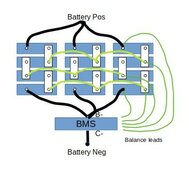soakupthesun
New Member
Hi folks,
I've done some digging, but haven't found an answer. I'm building my first battery pack, so have a lot of questions...
The battery is going to be built from a dozen 105AH EVE cells, 4 in series to make 12v. I have a single OverkillSolar 4S 120 amp BMS. With 12 cells total, the typical arrangement is for the cells to first get wired in sets of three, then the sets get wired in series. 3P, 4S. (Comma added for clarity.)
Mechanically, for flexibility in the future, the better arrangement for me might be to have the cells rotated 90 degrees, so there would be three 4S stacks (aimed positive / negative north / south) positioned side by side (east / west). So the wiring is first to have stacks of 4 cells wired in series, then the three stacks get wired in parallel. 4S, 3P. Fat wires of equal length pick up the ends of each of the stacks, connecting them to the BMS on the negative side and to the single post for positive. To use a single BMS for the whole lot, the 3 intermediate connections between the stacks need to be made, connecting the single set of sense wires to those points. I can't use bus bars for this, due to the cell arrangement.
So, the question: Do I need to use really really beefy wires (bus bar equivalent) between the stacks, or can I simply use some 12-14 gauge stranded wires for this? My logic is that since all the cells should be pretty well matched (they are all identical cells, ordered at the same time), there ideally shouldn't be any voltage difference (current flowing) between the three stacks at these intermediate points. In reality there will be some, but the current should only be what is needed for maintaining balance between the stacks, so the thinner wiring should be sufficient.
Yes?
If it helps - and this may be the key - the overall battery will rarely be fully fully charged. Most of the time the battery will sit at around 50% SOC. It will be subjected to light discharge rates relative to its capacity. Current draw will also normally be relatively light, around 10 amps peak on a daily basis, with charging peaking at maybe 15-20 amps for a few hours a day but mostly a lot less than that. I will be enabling the "balance while charging" option on the BMS, and hope that is sufficient. There's a secondary power source in the system that starts kicking in when the battery gets below about 40% (ramping to fully supporting the load at around 20% SoC), so it shouldn't ever go below that except in an extended power outage.
I've done some digging, but haven't found an answer. I'm building my first battery pack, so have a lot of questions...
The battery is going to be built from a dozen 105AH EVE cells, 4 in series to make 12v. I have a single OverkillSolar 4S 120 amp BMS. With 12 cells total, the typical arrangement is for the cells to first get wired in sets of three, then the sets get wired in series. 3P, 4S. (Comma added for clarity.)
Mechanically, for flexibility in the future, the better arrangement for me might be to have the cells rotated 90 degrees, so there would be three 4S stacks (aimed positive / negative north / south) positioned side by side (east / west). So the wiring is first to have stacks of 4 cells wired in series, then the three stacks get wired in parallel. 4S, 3P. Fat wires of equal length pick up the ends of each of the stacks, connecting them to the BMS on the negative side and to the single post for positive. To use a single BMS for the whole lot, the 3 intermediate connections between the stacks need to be made, connecting the single set of sense wires to those points. I can't use bus bars for this, due to the cell arrangement.
So, the question: Do I need to use really really beefy wires (bus bar equivalent) between the stacks, or can I simply use some 12-14 gauge stranded wires for this? My logic is that since all the cells should be pretty well matched (they are all identical cells, ordered at the same time), there ideally shouldn't be any voltage difference (current flowing) between the three stacks at these intermediate points. In reality there will be some, but the current should only be what is needed for maintaining balance between the stacks, so the thinner wiring should be sufficient.
Yes?
If it helps - and this may be the key - the overall battery will rarely be fully fully charged. Most of the time the battery will sit at around 50% SOC. It will be subjected to light discharge rates relative to its capacity. Current draw will also normally be relatively light, around 10 amps peak on a daily basis, with charging peaking at maybe 15-20 amps for a few hours a day but mostly a lot less than that. I will be enabling the "balance while charging" option on the BMS, and hope that is sufficient. There's a secondary power source in the system that starts kicking in when the battery gets below about 40% (ramping to fully supporting the load at around 20% SoC), so it shouldn't ever go below that except in an extended power outage.




